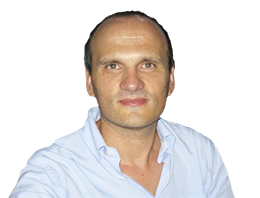 Have you ever wondered how our homes will be in the future? And how this future is being designed today?
Have you ever wondered how our homes will be in the future? And how this future is being designed today?
In the following, I discuss at length about these issues with an expert: Boris de Ruyter (see photo on the left) from Philips Research. Since 1994, Boris works on user-system interaction research at Philips Research headquarters in Eindhoven, where he is principal scientist and co-chairs the research domain Interactive
Healthcare.
He plays a key role in user planning and managing testing activities taking place inside facilities like Philips’ Home Lab. In this interview, we discuss with him about the exciting developments that are taking place in his lab.
I also wrote an article (in italian) on these topics and de Ruyter’s work, which appears in today’s printed edition of Il Sole 24 Ore (Nòva pages). [Un mio articolo (in italiano) sulle tematiche qui trattate appare sulle pagine di Nòva, nell’edizione del Sole 24 Ore oggi in edicola].
What is your role, as a psychologist, in designing new products for Philips?
"As psychologists, we bring in the human perspective in the development of applications of new technologies. In Research, we do not make products but develop innovative applications of existing/new technologies. These applications and their underlying technologies will then make it (in a modified form to meet for example the constraints of the target platform) into products. Since our (future) products are going to be used by humans, one needs to have knowledge on technology, humans and the way they will interact with these technologies.
In order to deliver high standard research results, we believe that all our work should be grounded in understanding: understanding technologies/materials but also understanding humans. Based on that understanding we can make significant progress in developing differentiating applications and technologies."
What are your current research goals?
"Our research goals are very similar over time: develop applications of existing/new technologies that will bring differentiating user experiences. Of course, our research domain changes from time to time. For example, our group has been very active in conducting user-centered research in the area of consumer electronics. The AmbiLight TV (see the following picture) is a nice example. With this concept, we started from the need to create feelings of immersion while watching TV. Our starting point was to understand human perception and cognition in this context. Next we developed and tested the concept. Later, the actual technology (to enable this concept on commercial products) was developed. Over time, we get involved in different application domains. Currently, I am very much involved in Ambient Assisted Living as a research domain. Very appealing about this application domain is that technology (and its applications) can have a significant and positive impact on society. This makes it both a challenging and exciting domain to work in."
Can you tell me more about Ambient Assisted Living and your project CareLab?
"About five years ago, we adopted the vision of Ambient Intelligence. Basically, this vision outlines that humans are central in an environment of technology that is addressing human needs. The aspect of embedding technologies into an environment and bringing appealing end user experience to life are so different from a more traditional (stand-alone, product) approach that we needed a simulation of a home environment to prototype and test these Ambient Intelligence concepts. Continuing this approach to user-centered research, we recently built a CareLab. CareLab is a simulation of an apartment for seniors. This apartment is equipped with lots of sensors that are used in our research on assistive solutions. What we see is that as technology is becoming intelligent (by means of the information captured with sensors and on which a system can reason), it can start coaching people in their day to day life.
So, CareLab is an instrument used in our research and more specifically in the evaluation of propositions in terms of their usability and basic acceptance. Before we develop and test these concepts, we first need to understand the context in which these solutions will be positioned. For that, we conduct first studies in context. More specifically, we conduct a number of context mapping studies to understand today’s context. Once we have carried out these studies, we can start working on new propositions that will be prototyped and tested in the CareLab. Next, these prototypes are positioned in the field. That means that we now do not bring people to the lab but bring the propositions to people’s homes. "
Can you give me some practical examples of the usefulness of these new technologies?
"The applications in CareLab are aimed at addressing the following core needs of seniors: social connectedness, safety & protection and stimulation. The purpose of these applications is to support seniors in maintaining an independent lifestyle by means of technologies that connect the society, monitor the safety of their environment and provide them with cognitive stimulation.
Cognitive performance is indeed known to decline as a result of aging. It is also known that mental activity can positively affect people’s cognitive performance. Through an interactive service, the elderly could train several distinct aspects of their cognitive capacities. Moreover, a community view representing members’ frequency of playing could induce a social motivation to further stimulate participation. The platform we propose for this service is an IP-TV (see the following picture) to allow for integration of multiple functionalities through a device that is familiar for the elderly. Our ongoing empirical studies have indicated that the elderly experience this as an attractive proposition while there are quantitative indications that such training enhances their performance on tasks related to selective attention and stimulus discrimination."
How does the concept of human-computer interaction change in these environments?
"There are a number of issues that are very different from the traditional human-computer interaction (HCI). First of all, we have to rethink the aspect of user control. In traditional HCI, the end-user has to be in full control. In Ambient Assisted Living (AAL), the question is "what price will the user will pay if he is in full control?". For example, can we afford the user to switch off a system that is providing safety and protection? Another issue that requires more attention than traditional HCI is the aspect of dependency: by providing these assistive technologies, there is an additional dependency on technology. In terms of designing solutions, we are confronted with the "design for all" challenge. That is: we should develop solutions for the seniors that are non stigmatizing, easy to use and still address the needs this target group has."
Among your innovative interaction techniques, you are using a robotic cat, the iCat (see picture below). Do you think anthropomorphizing the interaction between humans and machines could prove to be valuable? What role do you see for these robotic agents in the home of the future?
"In my opinion we should be very careful with this. The iCat is a research platform to investigate the role of multimodal and affective interfaces. It has also taught us that user’s expectations increase as we add more perceptive and reasoning capabilities to an interactive system. However, a mismatch between the user’s expectations and the system’s capabilities will result in more negative effects than the interactive advantages such technologies might bring. In that context, I am rather careful with "pushing" anthropomorphic systems."
What will be the next steps? Which further innovation do you think is needed to define our homes and lifestyles of the future?
"Well. All of these nice technological solutions need very careful research (and that is what we are doing). Additionally, many of these solutions will require some basic infrastructure (e.g. network facilities). This will take time to achieve high penetration. One can expect that the first introductions will be through institutionalized care facilities and hospitals, although there are also already consumer market type of solutions such as the Motiva system. This system uses today’s technologies to bring care services into the home environment."
How do you think a widespread diffusion of Ambient Intelligence will redefine our notion and perception of what we call “home” ?
"As mentioned previously, in our research we start from the so called context-mapping studies. With those studies we investigate today’s context in order not to disturb the emotional aspects of today’s home. For example, several years ago we conducted a context-mapping study into the meaning of "home". That highlighted how home is more than a building: it is a collection of emotionally significant events (or rituals) such for example breakfast with the family or bed time stories for the children. If one disturbed these rituals by introducing new technologies, end users would reject such technologies. So it is important to ensure that the "home" of today is not changed by AmI innovations."
[Photo Credits: Philips].





